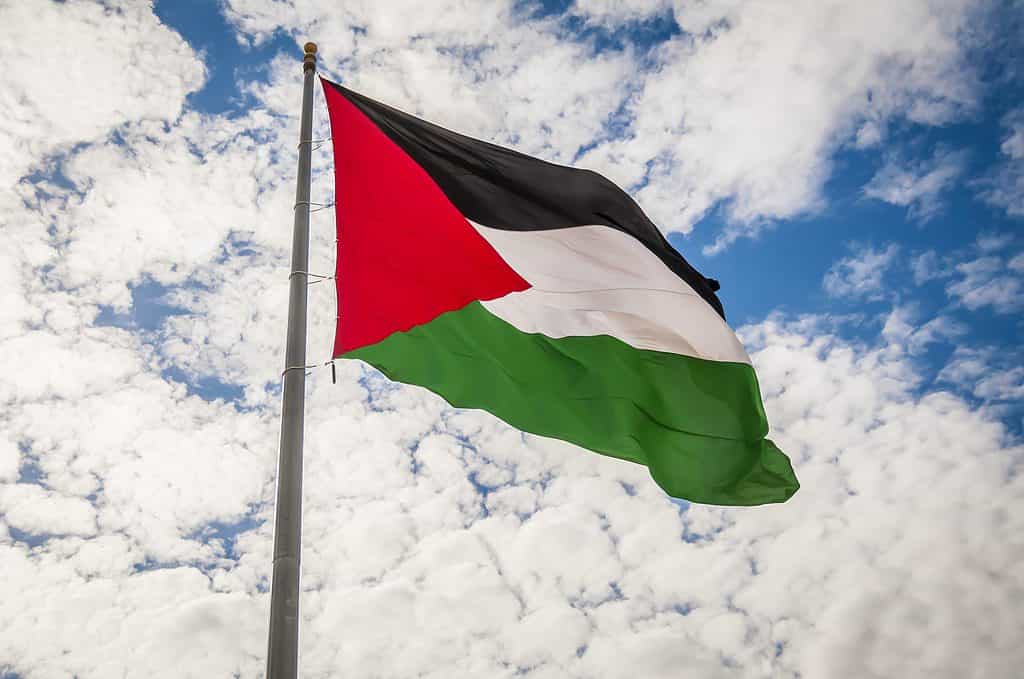The flag of the Palestinian territories has become a symbol of struggle, resilience, and hope for the Palestinian people. It is the most recognizable symbol of their fight for a homeland and freedom. The Israel-Palestine conflict is one of the most complicated political matters in modern history.
Despite being adopted in the late 1960s, this flag has rich historical roots that can be traced back centuries. It calls for justice, peace, and freedom for the Palestinian people. Its three colors – green, white, and black – each have distinct historical, political, and religious significance.
History of Palestine
The history of Palestine dates back thousands of years. This city was located near the fertile crescent of Ancient Mesopotamia and was likely one of the first places Homosapiens migrated. During the ancient Canaanite period (3000 BC), the region was known as Phoenicia. In the 16th century BC, the land became part of the Egyptian Empire until they withdrew in 1300 BC. Afterwards, the land became known as Israel and was inhabited by Israelites that dwelled in the region’s highlands.
The kingdom of Israel fell under Roman rule during the 1st century AD. There were several failed Jewish revolts against the Roman Empire during this time.
Jewish people began leaving Israel in significant numbers after the rise of Islam in the 7th century AD. Muslim kingdoms took control of the region and banned Judaism, resulting in a mass migration of the Jewish people.
This marked the end of “Israel” and the beginning of “Palestine.”
Palestine was a region of various Islamic kingdoms until the Ottomans controlled it in 1517 AD. Palestine was under Ottoman rule until the region was officially designated the British Mandate for Palestine in 1917. The British ruled the area until 1948. During that time, it had no autonomous flag.
Between 1897 and 1948, a movement called “Zionism” gained popularity. Jewish people all around the world were slowly moving back to “Israel,” or Palestine at the time.
After WWII and the genocide of more than six million Jews, the United Nations proposed a Partition Plan. This would divide Palestine into separate Jewish and Arab states. The Arab leadership rejected this proposal. However, in 1948 Israel declared independence. This led to the 1948 Arab Israeli War, during which hundreds of thousands of Palestinians were displaced from their homes.
Today, the Palestinian people are still fighting for a homeland and sovereignty. The flag of Palestine is a symbol of this struggle.
History of the Palestinian Flag

The red triangle represents the thousands of Palestinian people who have died through conflict.
©Roman Yanushevsky/Shutterstock.com
In the late 1960s, a Pan-Arab nationalism movement emerged in the Middle East. This called for the unification of Arab nations into one nation and began to shape the Palestinian political identity.
This nationalism led to the adoption of a flag for the Palestinian people. It was first raised in 1964 at the Palestine Liberation Organization (PLO) Convention in Cairo. The modern-day Palestinian flag is based on the Arab Revolt Flag, which was used during conflict with the Ottoman Empire in 1916-1918.
Before this, the Palestinian flag had no unified design. Instead, the people used various regional flags, such as red-white-green flags and tricolor flags of black-white-green. The colors were the same as those in earlier Palestinian flags, such as the one of 1948.
The flag of the Arab Revolt evoked pride and was a symbol of unity of the Palestinian people.
Symbolism in the Palestinian Flag
The three colors in the tricolor section of the Palestinian flag each carry distinct symbolism. The green stands for the Islam religion, representing hope and growth. The white symbolizes peace and purity, while the black represents the people’s oppression and struggle. The red triangle represents the thousands of Palestinian people who have died through conflict. The flag also represents the three major Abrahamic religions: Islam, Judaism, and Christianity.
According to another theory, the flag’s colors represent Arab’s four major religious and ethnic groups. Green is for the Fatimid or Rashidun caliphates, while white is for the Umayyad caliphates. Red represents the Hashemite dynasty and black stands for the Abbasid caliphate. Together, these four colors unite the Palestinian people in their fight for a homeland.
Similarity to Other Arab Flags
The Palestinian flag is often mistaken for the Jordanian flag. Both flags share the same Pan-Arab colors of green, white, and black. However, the Jordanian flag features a seven-pointed star. Sudan’s flag also bears a striking similarity to the Palestinian flag, though the order of the colors differs.
The similarity between the flags is due to the idealism of a unified Arab nation and the shared Arab identity.
Conclusion
The Palestinian flag symbolizes the courage and strength of the Palestinian people in their struggle for autonomy and a homeland. It represents pride, hope, and solidarity among the Palestinian people, while simultaneously paying tribute to the region’s rich history.
Though it is similar to other Arab flags, the Palestinian flag is unique in its symbolism. It stands as a reminder of the long fight for justice and freedom.
The flag is a common sight at protests and demonstrations, as well as in homes across the world. As such, it is both an icon of national identity and a powerful symbol of hope and resilience.
Up Next:
- The ‘Join, or Die’ Snake Flag’s Surprising History, Meaning, and More
- Red Flag with Green Star: Morocco Flag History, Meaning, and Symbolism
- Where Does the Jordan River Start? Discover the River’s Origin!
The photo featured at the top of this post is © rarrarorro/Shutterstock.com
Sources
- History.state.gov, Available here: https://history.state.gov/milestones/1945-1952/arab-israeli-war
- time.com, Available here: https://time.com/4056052/palestinian-flag-history/
- nam.ac.uk, Available here: https://www.nam.ac.uk/explore/conflict-Palestine#:~:text=In%20the%20aftermath%20of%20the,of%20the%20State%20of%20Israel
Thank you for reading! Have some feedback for us? Contact the AZ Animals editorial team.






